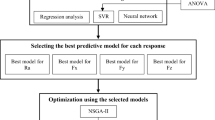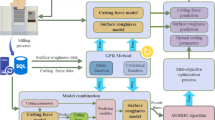Abstract
CNC end milling is a widely used cutting operation to produce surfaces with various profiles. The manufactured parts’ quality not only depends on their geometries but also on their surface texture, such as roughness. To meet the roughness specification, the selection of values for cutting conditions, such as feed rate, spindle speed, and depth of cut, is traditionally conducted by trial and error, experience, and machining handbooks. Such empirical processing is time consuming and laborious. Therefore, a combined approach for determining optimal cutting conditions for the desired surface roughness in end milling is clearly needed. The proposed methodology consists of two parts: roughness modeling and optimal cutting parameters selection. First, a machine learning technique called support vector machines (SVMs) is proposed for the first time to capture characteristics of roughness and its factors. This is possible due to the superior properties of well generalization and global optimum of SVMs. Next, they are incorporated in an optimization problem so that a relatively new, effective, and efficient optimization algorithm, particle swarm optimization (PSO), can be applied to find optimum process parameters. The cooperation between both techniques can achieve the desired surface roughness and also maximize productivity simultaneously.
Similar content being viewed by others
References
Kalpakjian S, Schmid SR (2001) Manufacturing engineering and technology. 4th edn. Prentice-Hall, Upper Saddle River
Kline WA, Devor RE, Shareef IA (1982) The prediction of surface accuracy in end milling. J Eng Ind 104:272–278
Lou MS, Chen JC, Li CM (1998) Surface roughness prediction technique for CNC End-Milling. J Ind Technol 15(1):1–6
Mansour A, Abdalla H (2002) Surface roughness model for end milling: A semi-free cutting carbon casehardening steel (EN32) in dry condition. J Mater Process Technol 124:183–191 DOI 10.1016/S0924–0136(02)00135–8
Arbizu IP, Perez CJL (2003) Surface roughness prediction by factorial design of experiments in turning processes. J Mater Process Technol 143-144:390–396 DOI 10.1016/S0924–0136(03)00407–2
Feng CX, Wang X (2002) Development of empirical models of surface roughness prediction in finish turning. Int J Adv Manuf Technol 20:348–356 DOI 10.1007/s001700200162
Lou SJ, Chen JC (1997) In-process surface recognition of a cnc milling machine using the fuzzy nets method. Comp Ind Eng 33(1–2):401–404 DOI 10.1016/S0360–8352(97)00122–8
Lou SJ, Chen JC (1999) In-process surface roughness recognition (isrr) system in end-milling operations. Int J of Adv Manuf Technol 15:200–209 DOI 10.1007/s001700050057
Lo SP (2003) An adaptive-network based fuzzy inference system for prediction of workpiece surface roughness in end milling. J Mater Process Technol 142:665–675 DOI 10.1016/S0924–0136(03)00687–3
Ozel T, Karpat Y (2005) Predictive modeling of surface roughness and tool wear in hard turning using regression and neural networks. Int J Mach Tools Manuf 45:467–479 DOI 10.1016/j.ijmachtools.2004.09.007
El-Mounayri H, Dugla Z, Deng H (2003) Prediction of surface roughness in end milling using swarm intelligence. IEEE Swarm Intelligence Symposium, 220–227
Smola AJ, Scholkopf B (1998) A Tutorial on Support Vector Regression, NeuroCOLT Technical Report NC-TR-98–030. Royal Holloway College, University of London
Lawtrakul L, Prakasvudhisarn C (2005) Correlation studies of HEPT derivatives using swarm intelligence and support vector machines. Monatsh Chem/Chem Month 136:1681–1691
Prakasvudhisarn C, Trafalis TB, Raman S (2003) Support vector regression for determination of minimum zone. ASME J Manuf Sci Eng 125:736–739 DOI 10.1115/1.1596572
Joachims T (1999) Making large-scale support vector machine learning practical. In: Scholkopf B, Burges CJC, Smola A (eds) Advances in kernel methods: support vector learning. MIT Press, Cambridge, pp 169–184
Platt JC (1999) Fast training of support vector machines using sequential minimal optimization. In: Scholkopf B, Burges CJC, Smola A (eds) Advances in kernel methods: support vector learning. MIT Press, Cambridge, pp 185–208
Tandon V, El-Mounayri H, Kishawy H (2002) NC end milling optimization using evolutionary computation. Int J Mach Tools Manuf 42:595–605 DOI 10.1016/S0890–6955(01)00151–1
Vapnik V, Golowich SE, Smola A (1997) Support vector method for function approximation, regression estimation, and signa lprocessing. In: Mozer M, Jordan M, Petsche T (eds) Advances in neural information processing systems 9. MIT Press, Cambridge, pp 281–287
Drucker H, Burges CJC, Kaufman L, Smola A, Vapnik V (1997) Support vector regression machines. In: Mozer M, Jordan M, Petsche T (eds) Advances in neural information processing systems 9. MIT Press, Cambridge, pp 155–161
Vapnik V (1995) The Nature of Statistical Learning Theory. Springer, New York
Kennedy J, Eberhart RC (1995) Particle Swarm Optimization. Proc of the IEEE Int Conf on Neural Networks (Perth, Australia), IEEE Service Center, Piscataway, NJ, 4, 1942–1948
Eberhart RC, Shi Y (2001) Particle Swarm Optimization: Developments, Applications and Resources. Proc of the 2001 Congress on Evolutionary Computation, IEEE Service Center, Piscataway, NJ, 81–86
Hu X, Eberhart RC, Shi Y (2003) Engineering optimization with particle swarm. Proc of the IEEE Swarm Intelligence Symposium 2003 (SIS 2003), Indianapolis, Indiana, USA. 53–57
Author information
Authors and Affiliations
Corresponding author
Rights and permissions
About this article
Cite this article
Prakasvudhisarn, C., Kunnapapdeelert, S. & Yenradee, P. Optimal cutting condition determination for desired surface roughness in end milling. Int J Adv Manuf Technol 41, 440–451 (2009). https://doi.org/10.1007/s00170-008-1491-8
Received:
Accepted:
Published:
Issue Date:
DOI: https://doi.org/10.1007/s00170-008-1491-8




